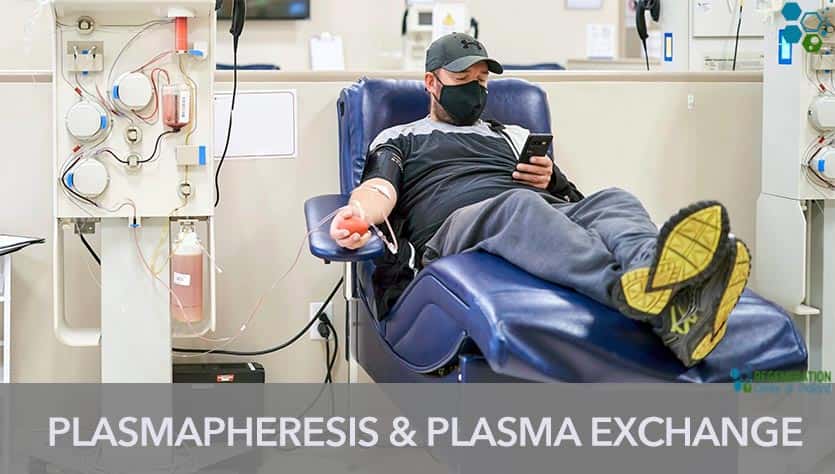Pheresis refers to the process of stem cell extraction from blood. It involves the passing of donor blood through an extraction machine and the eventual isolation of the stem cells (PDF Link) found within prior to pumping of the blood back into the heart and vascular system. The term “pheresis” (or “apheresis” from the Greek “to take away”) refers to a medical procedure in which the blood of a patient or donor is passed through an apparatus that separates out one particular component and returns the remainder to the circulation. This process allows for the selective removal or collection of specific blood components, such as platelets, plasma, or white blood cells.
Apheresis, Plasmapheresis, and Plasma Exchange
In recent years, more and more people have been turning to apheresis, plasmapheresis, and plasma exchange as medical treatments. But what are these procedures, and how do they work? In this article, we’ll explore the basics of apheresis, plasmapheresis, and plasma exchange, and take a closer look at how they can help patients.
What is Apheresis?
Apheresis is a medical procedure that involves removing blood from a patient, separating the blood into its individual components, and then returning the desired components to the patient. The word “apheresis” comes from the Greek word “aphairesis,” which means “a taking away.” Apheresis can be used to treat a variety of medical conditions, including autoimmune disorders, blood disorders, and neurological disorders. It can also be used to collect blood components for transfusions.
During the procedure, the patient’s blood is removed through a needle or catheter and passed through a machine called an apheresis machine. This machine separates the blood into its components, such as red blood cells, white blood cells, plasma, and platelets. The desired component is then collected, and the rest of the blood is returned to the patient.
What is Plasmapheresis?
Plasmapheresis is a type of apheresis that specifically targets the patient’s plasma. Plasma is the liquid portion of the blood that contains proteins, hormones, and other substances. Plasmapheresis is used to treat conditions that are caused by a problem with the patient’s plasma, such as autoimmune disorders. During plasmapheresis, the patient’s blood is removed, and the plasma is separated from the rest of the blood using an apheresis machine. The plasma is then discarded, and the other components of the blood are returned to the patient.
What is Plasma Exchange?
Plasma exchange is another type of apheresis that involves removing the patient’s plasma and replacing it with donor plasma or a plasma substitute. This procedure is used to treat a variety of medical conditions, including autoimmune disorders, blood disorders, and neurological disorders. During plasma exchange, the patient’s blood is removed, and the plasma is separated from the rest of the blood using an apheresis machine. The patient then receives donor plasma or a plasma substitute, and the rest of the patient’s blood is returned to them.
What Conditions Can Apheresis, Plasmapheresis, and Plasma Exchange Treat?
Apheresis, plasmapheresis, and plasma exchange can be used to treat a wide range of medical conditions. Some of the conditions that can be treated with these procedures include:
- Autoimmune disorders, such as multiple sclerosis, lupus, Hashimoto’d disease, fibromyalgia, rheumatoid arthritis and myasthenia gravis
- Blood disorders, such as hemolytic anemia and thrombotic thrombocytopenic purpura
- Neurological disorders, such as Guillain-Barre syndrome and chronic inflammatory demyelinating polyneuropathy
- Kidney disorders, such as Goodpasture syndrome and focal segmental glomerulosclerosis
- Skin disorders, such as pemphigus and bullous pemphigoid
- Transfusion-related complications, such as transfusion-related acute lung injury (TRALI)
What Are the Risks and Side Effects of Apheresis, Plasmapheresis, and Plasma Exchange?
Like any medical procedure, apheresis, plasmapheresis, and plasma exchange come with some risks and side effects. Some of the potential risks and side effects can include:
- Infection at the site where the needle or catheter is inserted
- Bleeding or bruising at the site where the needle or catheter is inserted
- Low blood pressure or fainting during the procedure
- Allergic reactions to the donor plasma or plasma substitute used during plasma exchange
- Fluid and electrolyte imbalances
It’s important to note that these risks and side effects are rare, and most patients tolerate the procedures well.
How Can Apheresis, Plasmapheresis, and Plasma Exchange Benefit Patients?
- Apheresis, plasmapheresis, and plasma exchange can provide significant benefits to patients with certain medical conditions. For example:
- Apheresis can help patients with blood disorders, such as sickle cell disease, by removing and replacing the abnormal red blood cells.
- Plasmapheresis can help patients with autoimmune disorders by removing the antibodies that are attacking their own tissues.
- Plasma exchange can help patients with neurological disorders by removing harmful substances from their plasma and replacing it with healthy donor plasma or a plasma substitute.
In some cases, these procedures can help patients avoid or delay the need for more invasive treatments, such as surgery or chemotherapy.
Apheresis, plasmapheresis, and plasma exchange are important medical procedures that can provide significant benefits to patients with certain medical conditions. While they do come with some risks and side effects, these are generally rare and most patients tolerate the procedures well. If you or a loved one is facing a medical condition that may be treated with apheresis, plasmapheresis, or plasma exchange, be sure to speak with your healthcare provider to determine if these procedures are right for you.

Several types of pheresis procedures exist, based on the component of blood being separated or collected:
- Plasmapheresis: This procedure involves removing the liquid part of the blood (plasma) and returning the blood cells to the donor or patient. It can be used for treating certain autoimmune disorders, such as myasthenia gravis or Guillain-Barré syndrome, where harmful antibodies are present in the plasma.
- Plateletpheresis: In this procedure, platelets are separated and collected from the blood. The remaining components, including red blood cells and plasma, are returned to the donor or patient. This is often done to collect platelets for donation, as platelets are essential for clotting and are frequently needed by patients with certain types of cancer or undergoing chemotherapy.
- Leukapheresis: Leukocytes (white blood cells) are separated and collected from the blood. This procedure might be used to decrease a very high white blood cell count in conditions such as chronic myeloid leukemia. It can also be used to collect certain types of immune cells for further modification and treatment, such as in chimeric antigen receptor (CAR) T-cell therapy for some types of cancer.
- Erythrocytapheresis: This process involves the removal of red blood cells. It might be used in conditions like polycythemia vera, where the body produces too many red blood cells.
- LDL Apheresis: This is a specialized procedure that removes low-density lipoprotein (LDL) cholesterol from the blood. It’s used for patients with extremely high cholesterol levels that don’t respond to medications or dietary changes.
Process of Apheresis
- The patient or donor is connected to a machine via a needle or catheter.
- Blood is drawn out and goes through a process that separates its components, often using a centrifuge.
- The desired component is either removed (in the case of treatment) or collected (in the case of donation), while the remaining parts of the blood are returned to the body.
Benefits of Apheresis
- Medical Treatments: Certain conditions can be managed or treated by removing the offending components and antigens from blood.
- Donation of plasma: It allows for the collection of specific blood components in larger quantities than would be possible from a standard blood donation.
Pheresis is a versatile medical procedure with applications in both treatment and donation, allowing for the targeted removal or collection of specific blood components.

